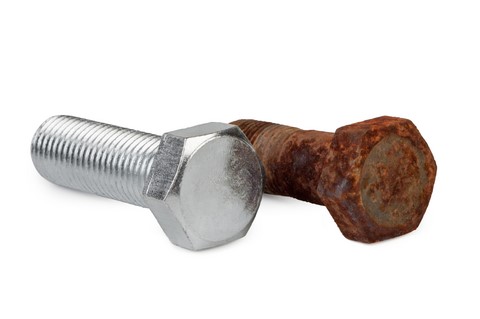Humidity Testing can be used to accelerate the aging of products that are affected by ambient humidity levels. Increasing the humidity above the normal use level humidity can cause defects or failures to occur in shorter times than what would be observed in the field. Humidity testing is most commonly performed along with testing at elevated temperature so that the resulting acceleration factor is affected by both humidity and temperature. The Acceleration Factor (AF) which is the ratio of the life at use conditions to the accelerated life at test conditions for temperature humidity testing is given by the following Arrhenius-Peck equation:
Humiditylow = average normal field use humidity level
Humidityhigh = test humidity level
Ea is the activation energy in electron-volts (eV)
K is Boltzmann’s constant (8.617385 x10-5 eV/K)
T is the temperature in degrees Kelvin
T1 = Field maximum temperature (°K)
T2 = Test maximum temperature (°K)
When establishing the actual test temperature-humidity level to be used, it must be realized that humidity can only be controlled up to approximately 98 °C as water will boil around 100 °C or below 5 °C as water will freeze. Commercially available temperature humidity chambers will have limits to the temperature humidity conditions that can be controlled so that test conditions must be chosen that fall with the controllable limits of the chamber.
As an example, assume a product that has normal upper operating limits of 50 °C and 60% RH. Testing the product at 85 °C and 85% RH would result in the following acceleration factor assuming a typical activation energy of 0.7eV:
AF = [(60/85)-2.66] X [e(0.7/.00008617385)((1/323.15)-(1/358.15))] ≈ 29.5
This means that 1 test hour is equivalent to 29.5 hours in the field. Testing for 1000 hours (≈6 weeks) at these conditions would therefore be equal to 3.4 years life at normal use conditions.
(1000 hours X 29.5)/((24 hours/day)(365 days/year))
Typical failures from accelerated humidity testing are:
- Oxidation and galvanic corrosion of metals
- Moisture absorption of plastic packaging materials used in semiconductors
- Degradation of electronic components
- Degradation or hermetically sealed products
- Swelling of materials due to water absorption
- Loss of material physical strength.
- Changes in electrical and thermal insulating characteristics
- Delamination of composite material
- Degradation of optical element transmission quality
Popular test specifications are:
- EIA-364-31C Humidity Test
- IEC 60068-2-30 Damp heat, cyclic
- IEC 60068-2-38 Composite temperature/humidity cyclic test
- IEC 60068-2-78 Damp heat, steady state
- MIL-STD-202, Method 103 Humidity (steady state) & Method 106 Moisture Resistance
- MIL-STD-810G, Method 507 Humidity
- MIL-STD-883, Method 1004 Moisture Resistance
- RTCA/DO-160, Section 6.0 – Humidity
- SAE J1455 Humidity
Delserro Engineering Solutions, Inc. (DES) has many years of experience performing Accelerated Humidity Testing and can assist customers in setting up a test using the proper test conditions. So, if you do not know what test conditions that you should use or what specification to choose then we will help you! Contact us or call 610.253.6637 to find out what DES can do for you!


really great article on temp humdi test.
in the formula there is -2.66 value used. On what basis we are using this value here. kindly suggest.
Regards
Jacob
That is the Peck relationship from the paper, COMPREHENSIVE MODEL FOR HUMIDITY TESTING CORRELATION by D. S. Peck (1986)
Can you explain what is the -2.66 meant for?
That is the Peck exponent from the paper, COMPREHENSIVE MODEL FOR HUMIDITY TESTING CORRELATION by D. S. Peck (1986)